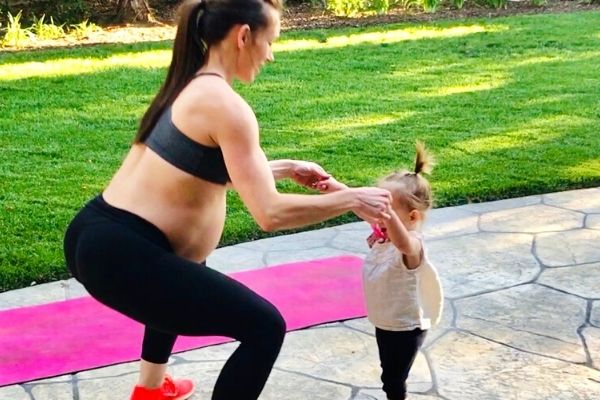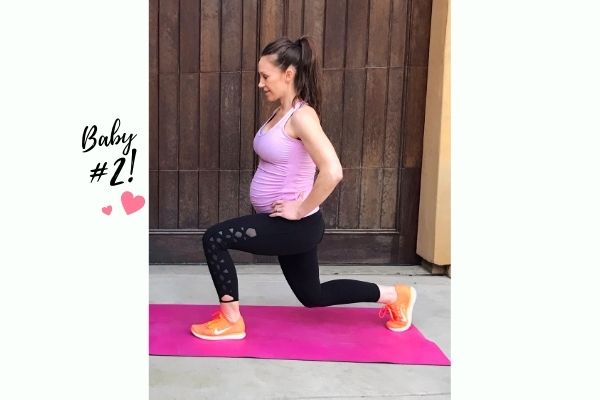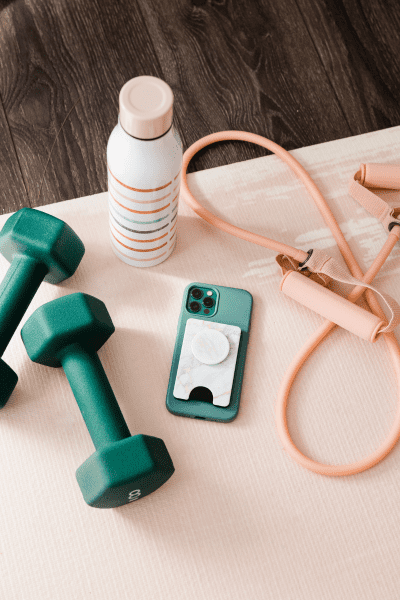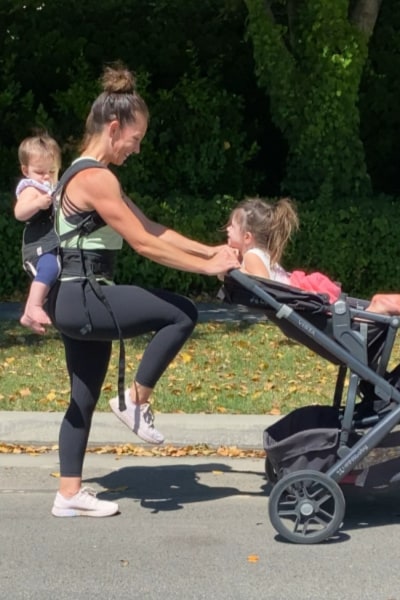12 Best Squat Exercises During Pregnancy For Strong Legs
Squats during pregnancy get a lot of attention but are they really all they’re cracked up to be?
If you ever needed some reassurance and motivation to squat during pregnancy, then this post is for you!

But like with most exercise during pregnancy, you’re probably wondering if they are safe, right?
In this post I dive into everything you ever needed to know about squatting during pregnancy to help you feel confident and reassured that squats do a body (and booty!) good during pregnancy!
Let’s begin with the basics.
Are Squats Safe While Pregnant?
From a physiological standpoint, yes, squats are most definitely safe during pregnancy.
This is like asking if it’s safe to sit on the toilet, sit into a chair or SQUAT down to pick something up off the floor.
All jokes aside, squatting is a natural movement we perform daily and you should be able to do them comfortably during all stages of life, including pregnancy.
Here’s the catch, not all squats are created equal and HOW you squat during pregnancy is more important than if they are safe.
But with any exercise during pregnancy, you should speak with your healthcare provider first or if you have any apprehension.
The Benefits of Squats During Pregnancy
Now that you know that squatting and most exercise during pregnancy is safe, let’s talk about the benefits of prenatal squats to help give you a little more motivation.
You may associate squats with being a “booty-builder”, but the benefits go way beyond just your glutes.
Squats during pregnancy will help:
- Strengthen Your Core
The main muscles used during squats include your quads and glutes.
However, you engage your core muscles every time you squats to stabilize your body during the movement.
- They Can Improve Pelvic Floor Strength
Your poor pelvic floor muscles take quite a beating during pregnancy!
The combination of the joint softening hormone “relaxin”, the weight of the baby, and physical labor can significantly weaken the pelvic floor muscles.
This can lead to complications including pelvic organ prolapse and urinary incontinence (both of which I have experienced first hand and are not fun).
While these things may be difficult to avoid during pregnancy, squats are a great exercise to help strengthen the pelvic floor to reduce these risks.
- Reduce Lower Back Pain
Squats help to strengthen your glute muscles which helps to stabilize and support the pelvis and may reduce lower back pain.
- Keep Your Cardiovascular System Strong
Have you ever noticed that doing squats makes your heart rate rise?
Squats are a great low-impact compound movement that will help get your heart pumping and keep your cardiovascular system strong which will help you during labor.
- Increase Muscle Mass to Boost Metabolism
Muscle burns more calories at rest than fat.
This means that doing exercises like squats can help build lean muscle mass and help your body to maintain a healthy weight gain during pregnancy.
Most people don’t want to focus on losing weight during pregnancy however a healthy, steady weight gain is very important for both you and your baby.
Other Benefits of Squats During Pregnancy
- Naturally helps open the hips and pelvis to prepare for labor
- Help maintain center of gravity and maintain balance and coordination
- Support your posture and may help relieve aches and pains
- May help prepare for a faster labor!
Related: 14 Prenatal Stretches Every Mama Needs During Pregnancy

When To Avoid Squats During Pregnancy
Now that you know the safety and benefits of squats during pregnancy, there are a few times when they should be avoided. And if you are concerned about these symptoms, discuss them with your healthcare provider.
Squats or any exercise be avoided during pregnancy if you have:
- Vaginal Bleeding
Some women may experience light spotting or bleeding early in pregnancy (AGOG), it is very important to mention this with your healthcare provider immediately and stop any exercise until you get the green light.
- Medical Reasons
If your doctor has mentioned any medical complications such as placenta previa, risk of preterm labor, low lying placenta you should either discuss prenatal exercise guidelines with your doctor or avoid squats all together.
- Pain
When exercising, especially during pregnancy, it is important to identify the difference between normal muscular pain and abnormal pain such as pinching, pulling, tingling or any other pain outside of muscular discomfort.
If you have any pain in your pubic bone, back, hips, hip flexors or knees, then stop and either readjust your form or pick another exercise.
- Feelings of Dizziness or Lightheadedness
If you are feeling dizzy or lightheaded, this is a sign that your body needs to slow down.
It could also mean you are dehydrated. Remember that your body needs extra hydration during pregnancy, especially if you are exercising.
Either slow your pace or skip the workout all together until you are feeling your best.
- Cramping, Contractions
If you have any cramping, contractions while performing any prenatal exercise then stop, hydrate and continue to monitor your symptoms.
Other Warning Signs to Stop Exercising During Pregnancy
- Leaking fluids
- Headaches
- Chest pain
- Muscle Weakness
How To Do Squats Correctly During Pregnancy
As your pregnancy progresses and the baby begins to grow, your center of gravity will shift.
If you are doing squats during your second and third trimester you will likely need to make adjustments to your foot placement and depth of squat.
While squatting is a natural movement, getting the correct form down can take some practice.
Key things to focus on while squatting during pregnancy:
- Stand with your feet hip width or slightly wider apart with your toes slightly pointed out. Imaging pressing your heels, big toe and outside of your foot through the ground.
- Before you squat, make sure you engage the core muscles.
- A squat is initiated at the hips. Think spreading the floor apart with your feet to activate your glutes, bending your knees and dropping your bottom down toward a chair or the ground.
- As you descend, keep the weight pressed through the heels, spine neutral (not curved or hunched) and chest up.
- The biggest mistake I see when people squat is allowing the knees to collapse toward each other. You want your knees pressing out in line with your big toe. This is why the cue spreading the floor with your feet can be helpful.
- Once you have reached the bottom of your squat, imagine pressing through the floor and squeezing your glutes to return to a standing position.

Can Squats Induce Labor?
Squats will not necessarily “induce labor” but rather they can help “encourage” or “support” labor.
To induce labor means to literally start labor unnaturally. This is usually done medically by your healthcare provider.
Our bodies go into labor when they are ready.
So, unfortunately, squats won’t necessarily help to “induce” labor.
However, they can help encourage and PREPARE you for labor which is just as important .
If your body is already starting the labor process on it’s own, then squatting can help encourage labor by improving your alignment and the position of the baby to put more pressure on the cervix.
How many Squats A Day Should I Do During Pregnancy?
“Squat 300 times a day for a fast labor” is a popular quote you see floating around Pinterest or the internet by the infamous midwife Ina May Gaskin.
You DO NOT need to do 300 squats a day to reap the benefits.
I will humbly admit that I am a pretty fit person and the thought of squatting 300 times a day during my third trimester sounds pretty rough.
I would suggest adding different variations of squats to your prenatal workout routine a couple times a week.
In the third trimester, you can practice daily deep squats and hold at the bottom for a few breaths to help stretch and open the pelvis but only if they are safe and comfortable for you and your pregnancy.
Related: 14 Must Know Tips To Plan The Perfect Prenatal Workout Routine
The Best Squat Variations During Pregnancy
Okay, now that we got all the nitty-gritty out of the way, let’s dive into the best squat variations during pregnancy.
I have listed this from simplest to more advanced.
1. Box Squat
The box squat is a very safe and easy exercise during pregnancy. It is basically the same movement you use sitting down on the toilet or sitting into a chair!
- Start with your feet shoulder width apart or slightly wider. Toes slightly turned out.
- Inhale and breathe into the sides of your ribcage and deep into your back.
- On the exhale, engage your core and lightly connect through the pelvic floor.
- Slowly lower your bottom toward the chair, keeping the weight in your heels and your knees inline with your toes, not caving in.
- Focus on preventing any excessive arching or curving in your low back.
- Once your bottom touches the chair, pause for a breath, then press through your feet to stand, keeping that light connection through your pelvic floor and low belly.
2. Parallel Squat
- Follow the exact same steps above but without a chair.
- Lower until your thighs are about parallel to the floor, hold for a breath and then press through the floor to return to the standing position.
- Make sure to focus on keeping the lower core and pelvic floor engaged.
3. Sumo Squat
This takes the hips in a wider range of motion with your feet wider than a traditional or parallel squat.
Note: If you have any pubic bone pain, this exercise should be done with caution or avoided.
- Start with your feet wider than shoulder width apart and toes slightly pointed out and your knees inline with your toes.
- Engage your lower belly and pelvic floor and lower into a squat depth that is comfortable for you and your pregnancy.
- Keep those knees from caving in and back in a neutral position.
- Squeeze your glutes, lightly lift your pelvic floor and press through your feet to stand.
4. Wall Squats with Exercise Ball
Using the support of an exercise ball against the wall is a great variation of squats during pregnancy.
- Place an exercise ball between your low back and the wall.
- Stand with your feet slightly in front of your body and about shoulder width apart.
- Engage your core and pelvic floor as you gently push against the exercise ball while lowering down into a squat.
- As your lower, you may need to adjust your feet to ensure your knees are at a 90 degree angle.
- Hold for a breath at the bottom then press through the floor to stand.
- If you feel any pressure on your knees, make sure your feet are far enough out in front of you and only go as low as feels comfortable.
5. Goblet Squat
- Start in a squat position as mentioned above. Hold a dumbbell or slightly heavy object about at chest height.
- Take a deep breath, engage your core and pelvic floor and descend down pushing your hips back and bending the knees. Imagine you are trying to drop your back pockets toward your heels.
- Once your thighs are parallel to the ground, exhale and press your feet through the floor to stand.
6. Deep Squat with Pelvic Floor Contraction
The deep squat is the best variation to really open up your hips and improve mobility. They are also a great exercise to help you learn to locate and relax your pelvic floor muscles.
- Start with your feet slightly wider than shoulder width apart.
- Descend into a squat position all the way to the ground.
- At the bottom of the squat, focus on contracting and relaxing your pelvic floor muscles (think Kegal).
- Hold this position for at least 10 seconds, then push through your feet to stand.
- You can also place a yoga block or pillow under your bottom for a little extra support.
When to Avoid Deep Squats
There are several situations when you may want to avoid deep squats during pregnancy because they do place more pressure on the pelvic floor. But as with anything, listen to your body and healthcare provider to evaluate your options!
- If you have hemorrhoids
- Feelings of bulging or heaviness in your pelvic floor
- Low lying placenta
- Risk of preterm labor
- Possibly if your baby is lying breech after 30 weeks. (you don’t need avoid squats for this but avoid going too deep)
7. Kneeling Squats
A kneeling squat is a great option for beginners who struggle with hip extension or just anyone wanting to activate and strengthen their glutes.
- Start in a kneeling position on the floor with your knees slightly wider than hip width apart and feet in line with your knees. The top of your foot should be resting on the floor.
- Clasp your hands together in front of you or hold a dumbbell.
- Engage your core and engage your glutes and begin lowering your glutes toward your heels.
- Once you have reached your heels, squeeze your glutes to drive your hips back up to the starting position. The movement up is all in the glutes.
8. Split Squat
The split squat nicely adds a little hint of difficulty to the squat for a little more challenge.
If you are in your second or third trimester, you may want to do this exercise holding onto a chair for support as your balance may be a little more off.
- Start with your feet together and step one foot forward as wide as possible while keeping both heels on the ground and toes pointing forward.
- Place your hands on your hips or holding dumbbells at your side.
- Engage your core and pelvic floor as you begin to bend both knees to lower toward the ground.
- Allow your back heel to come off the ground as you shift your weight down into the heel of the front foot.
- Make sure to keep your torso upright.
- Lower until your top leg and bottom shin are parallel to the ground.
- Pause then drive through the front heel to stand up.
9. Uneven Squat
This variation of the squat adds another element of strength and stability to the core, specifically your oblique muscles.
- Follow the same squat stance as mentioned above.
- Holding a dumbbell in your right hand, lower down into a squat position, keeping your core fully engaged to support the uneven distribution of the weight.
- You can put your other arm out to the side for balance.
- Lower until your thighs are parallel to the ground or a depth that is comfortable for you and your pregnancy.
- Once you have reached the bottom, press through your heels to stand.
10. Walking Squats
This is a fun and juicy exercise to help strengthen your legs and squeeze in a little heart pumping cardio, your legs will burn oh so good!
- Start in a squatting position and begin walking 4-5 steps forward then 4-5 steps backward.
- Be sure to stay squatted as low as you can while keeping that core firmly engaged.
Related: 5 Prenatal Ab Exercises For Love Handles
11. Assisted Squats
If squatting in any form is challenging, you can do assisted squats by holding onto a chair, your partner or my favorite, a TRX. This will help you strengthen your legs while also working on your form.
12. Wall Squat
The wall squat is one of my FAVORITE exercises during pregnancy and postpartum.
It is a great exercise to help engage and strengthen your lower back and core and build strength to improve your squat form.
- Begin with your back against the wall, feet slight out in front of you.
- Inhale and on the exhale, engage your lower abdominal muscle and slide your back partway down the wall, ideally until your thighs are about parallel to the ground.
- Arrange your feet so they are slightly wider than shoulder width apart for more support.
- Focus on using your core to keep your lower back pressed against the wall and squeezing your glutes.
- Remember to breath through the exercise and not hold your breath.
- Hold for the duration of the interval then press through the floor to stand.
Other Frequently Asked Questions About Squats During Pregnancy
My answer is “it depends”!
If you are going to do a full blow lower body squat workout, then yes, I would warm up your glutes and hips with some activation exercises.
However, squats can be considered a warm-up mobility exercise on their own. Just start slow until you feel warmed up
Another anwer, “it depends”!
If you have been fairly active prior to pregnancy and can squat with great form while using weight, then go for it.
If you are new to squats, start with bodyweight only with more reps until you develop the strength and movement pattern.
Another thing to keep in mind is that your joints are softer during pregnancy and adding extra weight could potentially cause some joint pain.
But like always, just listen to your body.
This will likely look a little different for everyone based on your pre-pregnancy fitness level, flexibility, your individual pregnancy and how well you can comfortably perform a squat.
As your pregnancy progresses, you may notice you cannot go as low.
This is perfectly okay, keep squatting!
You can either do parallel squats or deep squats, making sure you only work through YOUR comfortable range of motion.
Keep in mind that your joints are softer during pregnancy which can make them a little wobbly and unstable.
Final thoughts on Squats During Pregnancy
While squats are a great strength training exercise during pregnancy to help your body prepare for labor, the best strategy for your prenatal workout plan is to include a variety of exercises to strengthen your entire body.
Like always, I never want people to fear any exercise during pregnancy but feel confident staying active and adjusting as needed!
I would love to hear your experiences with squats during pregnancy? Did you love them or did you find them challenging?
Struggles of a Fit Mom uses only high-quality sources, including peer-reviewed studies, to support the facts within it’s articles. Read my editorial process to learn more about how I fact-check and keep my content accurate, reliable, and trustworthy.
Resources
ACOG. (September, 2019). Bleeding during pregnancy. Retrieved from
https://www.acog.org/womens-health/faqs/bleeding-during-pregnancy
ACOG. (July, 2019). Exercise During Pregnancy. Retrieved from
https://www.acog.org/womens-health/faqs/exercise-during-pregnancy

Brooke is a certified Prenatal and Postnatal Exercise Specialist with a Bachelors of Science degree in Kinesiology-Exercise Science. She is also a mom of 3 girls with more than 15 years of experience in health and fitness. Brooke’s goal at Struggles of a Fit Mom is to help motivate, educate and inspire other busy mamas who struggle with finding time, energy and motivation to take care of themselves in the chaos of motherhood.



![8 Tips To Make Your Days a Breeze [as a Stay at Home Mom]](https://www.strugglesofafitmom.com/wp-content/uploads/2020/09/Blank-450-x-450.png)



